When I was a kid, a bunch of us would go to a place in Bogota, NJ and pick up old military surplus arms; .45-70 Springfields, 11MM Rolling Blocks, even Civil war swords and WW II memorabilia. Of course that was at a time when a person could walk into a favorite discount department store, purchase a 2 or 4 groove barrel ’03 Springfield or a 1917 Enfield, and clear the checkout with no more fanfare than the rest of the household items poking out of the shopping cart. Sounds a little out of control until you realize, even adjusting for population increases, how few gun deaths and violent crimes there were back then.
The oldest of these relics and for black powder shooting, and a lot of fun. In support of the firearms purchases, there were also purchases of bandoliers and web ammo belts filled with pervasively green, damp, black powder filled cartridges. My greatest challenge to shooting accuracy was being able to hold on the target through trigger pull, hammer slow motion fall, an uncomfortable short silence for ignition, and the gun finally going off…..if it went off. Our rule of thumb was five minutes of silence, not unlike our firecracker rule, allowed enough time to lapse for an official dud declaration. When things did go right, there would be a bellicose boom through a cloud of smelly sulfur smoke, what we assumed to be envious stares from other shooters on the firing line, and tearing eyes that would temporarily obscured perfectly undisturbed 50 yard targets. It was fond memories, such as these, that caused me to not go near a black powder firearm for at least the next 45 years, yet somehow drew my interest today, and started me thinking I should look for a black powder gun. Unfortunately, times have changed, and that once clunker acquisition of decades ago has become a $3,000 collectors piece, even with its mechanical warts and all of the accompanying drawbacks. Still, in the midst of WSM and SUM stupor inducing saturation, I felt I needed to work with something different, something I clearly didn’t understand at all – black powder firearms.
I scanning a lot of web sites, read a lot of articles, and remembered I had recently seen, at the outdoor range, people dressed up in funny clothes and pretending they we reliving some distant past battle for American sovereignty and freedom…..only with a soda machine, and snack bar, and a parking lot full of shinny new pickup trucks and oversized SUV’s. Finding a place to jump in on this black powder stuff isn’t all that easy. There are lots of period types of guns, and lots of reasons for shooting black powder, and a cross over of hunters and collectors and shooters, and high and low performance pieces, and target and field pieces, and… I suppose it is a lot like smokeless powder guns for a novice. To avoid the risk of running around in circles for a few weeks without advancing the ball, so to speak, I decided I would look in the direction of something in black powder that was consistent with my smokeless firearm interests; performance, accuracy, utility and, hopefully, mechanically interesting.
I decided I didn’t want a black powder cartridge gun. I felt such equipment would represent only diminished performance in comparison to my smokeless powder powered firearms. On the other hand, the idea of packing powder down a bore, behind a projectile to see how fast it would go, seemed to offer an interesting upside potential, where high performance to the uninformed (that would be me), would be a pleasant surprise. So I bought a book “Black Powder Handbook & Loading Manual”, published by Lyman, written by Sam Fadala, to gain a very basic understanding of the subject, and move me along toward a purchase.
 It appears black powder firearms are defined by several characteristics. The first, as handguns, rifles and shotguns. Then they are further categorized by ignition source; flint, percussion cap and modern primer. Propellant is another point of division, black powder, modern black powder substitute, in granulated grades, and size of pellet. Projectiles differ; round ball, conical and sabot wrapped bullets. Beyond these distinctions, there are original period firearms, reproductions, hybrid reproduction, custom rifles, and modern muzzle loaders such as inline magnum level performers. In truth there are many interesting firearms, with lots of character and personality. I needed to keep my experiments simple, make that cheap, in the event I found I wasn’t going to sustain an interest in these types of firearms, or in the event more information results in the awareness that my initial selections were less than optimal.
It appears black powder firearms are defined by several characteristics. The first, as handguns, rifles and shotguns. Then they are further categorized by ignition source; flint, percussion cap and modern primer. Propellant is another point of division, black powder, modern black powder substitute, in granulated grades, and size of pellet. Projectiles differ; round ball, conical and sabot wrapped bullets. Beyond these distinctions, there are original period firearms, reproductions, hybrid reproduction, custom rifles, and modern muzzle loaders such as inline magnum level performers. In truth there are many interesting firearms, with lots of character and personality. I needed to keep my experiments simple, make that cheap, in the event I found I wasn’t going to sustain an interest in these types of firearms, or in the event more information results in the awareness that my initial selections were less than optimal.
I decided on a modern design in-line muzzle loader. I liked the reliable shotgun primer ignition system, I liked not having to handle or measure granulated powder during this first attempt, I liked the rifled barrel and professed flat trajectory .45 caliber bore, and I liked the high performance levels of a 3 Pyrodex pellet charge. There is a huge range of prices for these types of firearms, not unlike the price ranges that apply to firearms of more current design. Operations like Cabela’s offer broad selections of these types of rifles, as well as supporting accessories. Some of those consistent with the chosen in-line direction are noted below.

Austin & Halleck’s product is more toward the upper midrange of mass produced inlines at $550. The rifles come with two stocks, one synthetic and one figured maple. They feature a fast lock time, adjustable trigger and a .50 caliber bore. The ignition is by 209 shotgun primer. The model illustrated above is made from carbon steel, however, stainless models are available for approximately $30 more. Unlike guns exposed to smokeless powder, stainless does not have any greater resistance to sulfur based powder induced corrosion and will not save on time spent cleaning, however, the external environmental durability of stainless steel remains. – Conclusion ? Too expensive and overly featured for my purposes.

Knight rifles are available in a broad range of prices. The master, shown at the right, is a $900 two type laminate and synthetic stocked stainless steel wonder, sold in .45 and .50 caliber versions. On the other end of the Knight spectrum, with lots of models in between, is a Wolverine model starting at $260. They all use 209 primers and handle heavy powder charges. Still to expensive for my half hearted muzzle loader effort.

CVA offers a number of configurations of in-lines on a scale of reasonable price, that runs from the top of the line $350 Firebolt Magnum, to the $99 Staghorn Magnum. They all utilize 209 primer ignition, or a combination of ignition systems, and they all handle heavy pellet and granulated powder charges. I would compare the CVA line in price point to Savage’s in the world of smokeless powder rifles. It was in the midst of this inexpensive plastic and blued carbon steel, I decided to take a stab at black powder firearm ownership. I placed an online order with Cabela’s for a , received an immediate order placement confirmation, then a notification of shipment with tracking number, then 3 days later the gun arrived. Neat.
The arrival
The gun and kit option contain the HunterBolt 209 Magnum rifle, 8 oz. of Cabela’s Black Powder Solvent, 8 oz. cleaning basket for nipples and other small parts (I know, that sounds funny to me also), .45 caliber sabots with 180 Gr. bullets, nylon tubular powder flask, short starter, brass powder measurer, and a #11 straight in-line capper. There is also a Cabela’s Pine Ridge® 2.5-7X variable scope mounted with Quic-Kee 1″ rings and Weaver style bases. The gun’s barrel is of blued carbon steel with a bullet load guiding recessed muzzle. The one-piece MonoBlock barrel and receiver is drilled and tapped for scope mounting and is fitted with CVA’s own Illuminator™ fiber optic sights. Finally, Cabal’s included all tools for disassembly: 209 capper/extractor, cleaning jag, synthetic ramrod. That’s a lot of equipment for $230, in today’s market, about the price of a not quite decent .22 rim fire rifle.
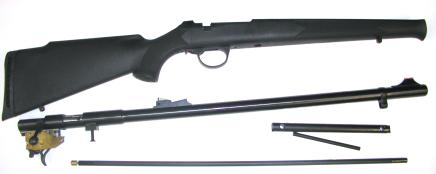
The gun was in a smallish Connecticut Valley Arms box, complete with the address of CVA’s Norcross, Georgia corporate location, as well as the gun’s proud Spanish origins. I was pleased to see the ISO 9001 and 14001 manufacturing certification imprinted on the box. I’m not use to receiving firearms this way, but there clearly weren’t many parts and assemblies to be concerned with. There was a rather basic grade synthetic stock, a heavily preservative grease covered barreled action, a ram rod packed originally in the barrel’s bore and, what I currently believe to be, a breech plug tool. There was also a rather sketchy manual that makes the inexperienced owner work overtime to figure out what’s in the box, and how to use it’s contents. Factory’s should never underestimate how jerky and blank slate new muzzle loader owners can be.
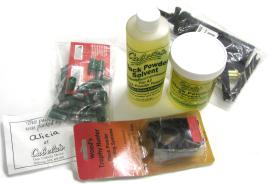
I dug around in the remaining items packaged separately from the rifle, and found almost all of the other kit material, including a note from a person named Alicia to inform me she had packaged my shipment. The only thing missing was a scope. I communicated with Cabela’s customer service via e-mail, got a very quick response with questions of clarification, then silence. I called Cabela’s customer service, toll free, and was told the missing scope would ship immiediately, and arrive in 3 to five working days. Not bad service if the scope shows up and, based on quality of initial service, I have no reason to doubt that it won’t.
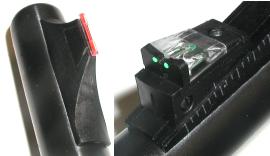
The Illuminator sights are a change of pace for me, but they seem well thought out, as they show up well against a dark or mottled background. I don’t believe I could muster enough open mindedness to place these types of sights on one of my more modern firearms. The front sight is mounted on a traditional dovetail within a ramp, and the rear sight is fully adjustable for both windage and elevation. The parts are ok for a gun of this type, but in other applications might be considered a little rough around the edges.
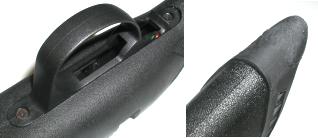
The low purchase price showed in ways that would be anticipated, quality of material, as well as fit and finish of the same. The stock is a molded composite piece, I assume fiber filled plastic, complete with mold parting lines running longitudinally down the underside of the stock. The recoil pad is decent in size and shape, however, it appears to have been sized to fit a variety of firearms, or dimensional run out in production stocks. The trigger guard is plastic also, which isn’t a big deal as even higher end products like Thompson Centers muzzle loaders also employ this material at the same locations. I’m not complaining, just explaining how a rifle could be constructed and sold for such a low price.
Tools & accessories
Black powder shooting brings with it some items that are unique to the propellant and ignition systems, as well as others that are familiar ti all shooters. The items that follow were included in the Cabela’s rifle and kit package.
The CVA in-line parts kit – The Allen wrench is used in rifle disassembly; bolt and barreled action to stock fastener. The plug screws fill in the scope mount holes in the barrel, when scope mounts are not in place on the rifle. Since the mount holes on the breech end of the barrel are through holes, I’m sure the gun functions better with the holes plugged or with scope mounts in place, than as uniquely placed compensator vents.
The last component in the parts kit is a 209 primer capper/decapper tool that is used to position in, or remove from, the breech plug a 209 shotgun primer. At one point in time, judging from the CVA site and CVA manual representations, these rifles shipped with breech plug nipples for #11 percussion and musket caps, as well as the 209 shotgun primer. They do not at this time, but rather are configured only for the shotgun primer, as clearly noted on Cabela’s site. Since this is the preferable choice of ignition, particularly with pellet powder loads, there is nothing lost with this omission of optional parts. The pieces are still sold separately by CVA.
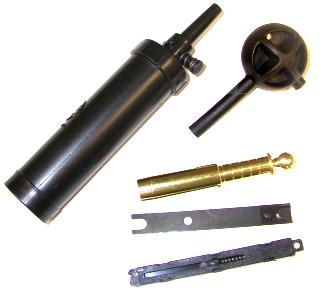
The CVA shooting accessories provided by Cabela’s are functional, however I suspect these might be, “The kids are all going to make fun of me quality”, but I honestly don’t know at this time. The Hunterbolt In-line rifle appears to be at its best with increments of 50 grain Pyrodex pellets, rather than granulated powder, so the flask (top right) and brass powder measure (center) probably won’t see much use, initially.
The plastic (or space age polymer as noted) flask hold 5 oz of powder; black powder is measured by volume, not weight. The brass CVA hunter Powder Measure telescopes in 10 grain increments for a measuring range between 60 and 130 grains. The 209 capper/decapper (below brass measure) is a duplicate of the one in the CVA In-line rifle parts kit enclosed in the rifle carton, and the #11 Inline capper is for use with #11 percussion caps only. This last tool holds 12 caps and makes for safer insertion when these are used. Since the rifle came without a #11 percussion cap nipple, and the 209 is a superior ignition component, I will probably use the percussion cap dispenser as a keychain, door jam, or long thin paperweight. The bullet starter, top right, moves the projectile into the bore where the ramrod takes over the task of seating it up against the powder charge; gaps between the are a not ok in black powder shooting. The ramrod, not shown, is grasped not more than 8″ from the muzzle when driving the projectile home to prevent excessive flexing, and hand puncturing rod breakage.
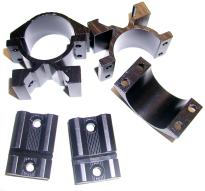
The scope mounts, sitting next to the empty space that is reserved for arrival of the missing scope from Cabela’s, are utility grade and consistent with a cost effective shooting setup. The bases are Weaver type and the lower ring halves are one piece, so the rings are clamped to the base by tightening them to distortion. I’ll put these on blindfolded so I don’t have to watch. All fasteners were included.
The mounts were labeled “Wood’s Trophy Hunter Black Powder Mounting systems” and manufactured by Quic Kee, Inc. – of course. I tried to dig up a web site for the mounts, but the URL quickee resolved to a copy center service, however, we all know that result could have been worse.
Packed in the getting started kit were 20 “Cheap Shot Sabots”, hollow point bullets, labeled as Thompson/Center product. The package is marked .45/.40 Caliber, the designations are for the sabot and actual bullet diameters respectively, the pure lead bullet weight is 180 grains. After mentally mocking the name, I measured the bullets, all .400. I measured the plastic sabots at the transition waist, .450. I dropped them on a scale 179.4~180.0 grain, 190 grains as an assembly. I mentally apologized for the unwarranted criticism.
Projectile options will take some exploration on my part. CVA recommends their own Power Belt bullets. These have a plastic base designed to protect the soft lead bullet from gas cutting, and are full bore diameter bullets. They also come in copper clad hollow points and streamlined plastic tip insert AeroTip styles. Weights run 195~275 grains. CVA also recommends standard full bore diameter conical bullets, and .45/.40 bore sabots from established manufacturers such as Barnes. Patched round ball projectiles are not used in this particular model firearm because of it’s fast 1:28 for a muzzle loader rifling twist, which would guarantee firearm inaccuracy. Bullets are all pure lead to control accurate sizing, and resulting pressure firearm.

 Muzzle loader bullets are not cheap, even if their labels suggest so. The PowerBelt bullets for the .45 caliber bore run about $19 to $20 for 20. There are some variations on the theme , but it seems bullet manufacturers got together and decided you’ll pay a buck or so a bullet if you want to shoot an in-line, whether plain conical, or dude fancy Barnes Expander MZ Sabots. Actually, muzzle loader shooting overall isn’t isn’t in any aspect other than the actual firearm. If you can find local Pyrodex 50 grain pellet supply, and you shoot magnum loads of three pellets per, you’ll pay 75¢ per round just for powder – they run approximately $12 per box of 50 pellets, plus tax. If you can’t find local supply and you need to order mail order, there is a $20 per shipment hazmat fee, so you’d probably want to order more than one 50 pellet box at a time. A few more cents added for a 209 primer and cleaning solvent after each shot, you get to pay the equivalent of $40 for the equivalent of 20 rounds of cartridge ammo, without brass.
Muzzle loader bullets are not cheap, even if their labels suggest so. The PowerBelt bullets for the .45 caliber bore run about $19 to $20 for 20. There are some variations on the theme , but it seems bullet manufacturers got together and decided you’ll pay a buck or so a bullet if you want to shoot an in-line, whether plain conical, or dude fancy Barnes Expander MZ Sabots. Actually, muzzle loader shooting overall isn’t isn’t in any aspect other than the actual firearm. If you can find local Pyrodex 50 grain pellet supply, and you shoot magnum loads of three pellets per, you’ll pay 75¢ per round just for powder – they run approximately $12 per box of 50 pellets, plus tax. If you can’t find local supply and you need to order mail order, there is a $20 per shipment hazmat fee, so you’d probably want to order more than one 50 pellet box at a time. A few more cents added for a 209 primer and cleaning solvent after each shot, you get to pay the equivalent of $40 for the equivalent of 20 rounds of cartridge ammo, without brass.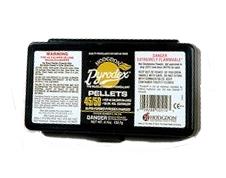 $40 is about about twice the cost of reloading for my .416 Weatherby Magnum with premium bullets. 100 grain Pyrodex practice loads would shave about $5 off the 20 round cost, and switching to FFG granulated Pyrodex 100 grain loads would shave $12 off the cost of 20 rounds…maybe that term is volley rather than round?. I think if I were going to take black powder shooting seriously, I’d probably look at alternative propellants and start casting my own bullets.
$40 is about about twice the cost of reloading for my .416 Weatherby Magnum with premium bullets. 100 grain Pyrodex practice loads would shave about $5 off the 20 round cost, and switching to FFG granulated Pyrodex 100 grain loads would shave $12 off the cost of 20 rounds…maybe that term is volley rather than round?. I think if I were going to take black powder shooting seriously, I’d probably look at alternative propellants and start casting my own bullets.And then……….
OK, so I’m waiting for a missing scope replacement, a source for Pyrodex, a selection of bullets, and the new gun is buried in all sorts of crud. I am going to spend a little time disassembling and cleaning the beast, then mount the scope and work up a list of test loads and projectiles I can haul up to the range…hopefully soon.
Thanks
Joe

 It appears black powder firearms are defined by several characteristics. The first, as handguns, rifles and shotguns. Then they are further categorized by ignition source; flint, percussion cap and modern primer. Propellant is another point of division, black powder, modern black powder substitute, in granulated grades, and size of pellet. Projectiles differ; round ball, conical and sabot wrapped bullets. Beyond these distinctions, there are original period firearms, reproductions, hybrid reproduction, custom rifles, and modern muzzle loaders such as inline magnum level performers. In truth there are many interesting firearms, with lots of character and personality. I needed to keep my experiments simple, make that cheap, in the event I found I wasn’t going to sustain an interest in these types of firearms, or in the event more information results in the awareness that my initial selections were less than optimal.
It appears black powder firearms are defined by several characteristics. The first, as handguns, rifles and shotguns. Then they are further categorized by ignition source; flint, percussion cap and modern primer. Propellant is another point of division, black powder, modern black powder substitute, in granulated grades, and size of pellet. Projectiles differ; round ball, conical and sabot wrapped bullets. Beyond these distinctions, there are original period firearms, reproductions, hybrid reproduction, custom rifles, and modern muzzle loaders such as inline magnum level performers. In truth there are many interesting firearms, with lots of character and personality. I needed to keep my experiments simple, make that cheap, in the event I found I wasn’t going to sustain an interest in these types of firearms, or in the event more information results in the awareness that my initial selections were less than optimal.






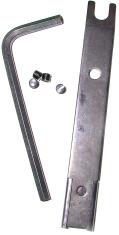


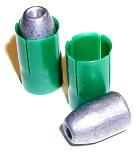

 Muzzle loader bullets are not cheap, even if their labels suggest so. The PowerBelt bullets for the .45 caliber bore run about $19 to $20 for 20. There are some variations on the theme , but it seems bullet manufacturers got together and decided you’ll pay a buck or so a bullet if you want to shoot an in-line, whether plain conical, or dude fancy Barnes Expander MZ Sabots. Actually, muzzle loader shooting overall isn’t isn’t in any aspect other than the actual firearm. If you can find local Pyrodex 50 grain pellet supply, and you shoot magnum loads of three pellets per, you’ll pay 75¢ per round just for powder – they run approximately $12 per box of 50 pellets, plus tax. If you can’t find local supply and you need to order mail order, there is a $20 per shipment hazmat fee, so you’d probably want to order more than one 50 pellet box at a time. A few more cents added for a 209 primer and cleaning solvent after each shot, you get to pay the equivalent of $40 for the equivalent of 20 rounds of cartridge ammo, without brass.
Muzzle loader bullets are not cheap, even if their labels suggest so. The PowerBelt bullets for the .45 caliber bore run about $19 to $20 for 20. There are some variations on the theme , but it seems bullet manufacturers got together and decided you’ll pay a buck or so a bullet if you want to shoot an in-line, whether plain conical, or dude fancy Barnes Expander MZ Sabots. Actually, muzzle loader shooting overall isn’t isn’t in any aspect other than the actual firearm. If you can find local Pyrodex 50 grain pellet supply, and you shoot magnum loads of three pellets per, you’ll pay 75¢ per round just for powder – they run approximately $12 per box of 50 pellets, plus tax. If you can’t find local supply and you need to order mail order, there is a $20 per shipment hazmat fee, so you’d probably want to order more than one 50 pellet box at a time. A few more cents added for a 209 primer and cleaning solvent after each shot, you get to pay the equivalent of $40 for the equivalent of 20 rounds of cartridge ammo, without brass. $40 is about about twice the cost of reloading for my .416 Weatherby Magnum with premium bullets. 100 grain Pyrodex practice loads would shave about $5 off the 20 round cost, and switching to FFG granulated Pyrodex 100 grain loads would shave $12 off the cost of 20 rounds…maybe that term is volley rather than round?. I think if I were going to take black powder shooting seriously, I’d probably look at alternative propellants and start casting my own bullets.
$40 is about about twice the cost of reloading for my .416 Weatherby Magnum with premium bullets. 100 grain Pyrodex practice loads would shave about $5 off the 20 round cost, and switching to FFG granulated Pyrodex 100 grain loads would shave $12 off the cost of 20 rounds…maybe that term is volley rather than round?. I think if I were going to take black powder shooting seriously, I’d probably look at alternative propellants and start casting my own bullets.
Email Notification